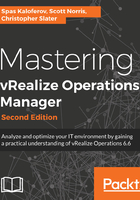
Deployment examples
Let's take a look at a few common deployment scenarios:
Example 1:
In this scenario, you have multiple vCenter Server instances in a single data center.
Deploy at least one node, and scale out as needed:

In this scenario, you deploy a vRealize Operations cluster in the main data center. You configure a vCenter adapter for each VMware vCenter Server instance. You monitor all vCenter Server instances from a single product user interface.
Example 2:
In this scenario, you have multiple vCenter Server instances in one data center, like you did in the previous example, but in addition, you have a vCenter Server instance in each remote data center location:

In this scenario, you deploy a vRealize Operations cluster in the main data center. You configure a vCenter adapter for each VMware vCenter Server instance in the main data center. You monitor all vCenter Server instances from a single product user interface.
In addition, you deploy a remote collector node in each remote data center location. Each remote collector node has a vCenter adapter installed that monitors the vCenter Server instance at that location.
Users at the remote locations log into the product user interface at the main data center:
Example 3:
In this scenario, you have multiple vCenter Server instances in two main data centers. This is the same design as in Example 1, but it has been replicated for each data center.

In this scenario, you deploy separate vRealize Operations clusters in each data center. You configure a vCenter adapter for each VMware vCenter Server instance in each of the data centers. You monitor the vCenter Server instances in a data center from a single product user interface. Users log in locally to their cluster.